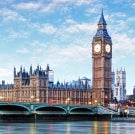Greece will set up an emergency escape port on Santorini to ensure people can safely leave the island should a larger earthquake strike.
The popular Aegean Sea tourist destination has experienced tens of thousands of minor tremors since late January, prompting authorities to implement precautionary measures, including construction bans, school closures, and evacuations from nearby islands.
While no significant damage has been reported on the island, scientists describe the seismic activity as unprecedented, even for earthquake-prone Greece, and have not ruled out the possibility of more powerful tremors.
Concerns have been raised about the vulnerability of Santorini’s main ferry port, situated at the base of a steep slope, and other locations on the island.
Civil Protection Minister Vassilis Kikilias announced the plan to construct the evacuation port, which will facilitate the safe docking of passenger ferries, as a temporary measure until new port infrastructure is completed.
“Along with the new port in Santorini which is being prepared, there was a decision for setting up an escape port on the part of the island where passenger ferries would be able to dock in an emergency,” he said in an interview with Greek ANT1 television.
Although the tremors lessened over the weekend, local authorities extended emergency measures for a third week on Sunday and reiterated calls for people to stay away from coastal areas and steep hillsides prone to landslides.
“This story is not over,” Costas Papazachos, a seismology professor, and a spokesperson for the Santorini quakes told public broadcaster ERT.
“Both authorities and habitants should get used to a rather unpleasant situation for some time, it could be another two, three months.”
Santorini took its current shape following one of the largest volcanic eruptions in history, around 1600 BC.
Seismologists have said the latest seismic activity, the result of moving tectonic plates and magma, has pushed subsurface layers of the island upwards.
Source: independent.co.uk



